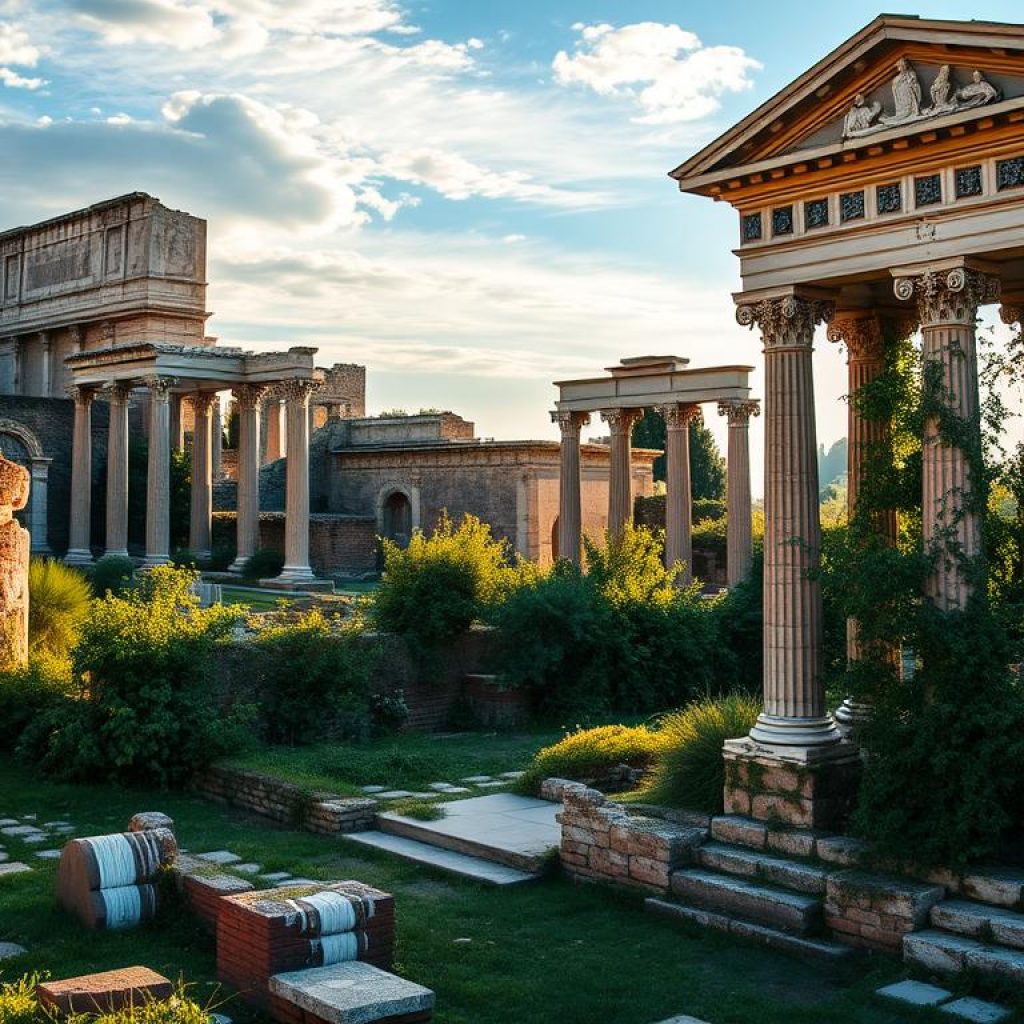Palatine Hill: Ancient Heart of Imperial Rome
The Palatine Hill is the most famous of Rome’s seven hills. It’s a key historical site in the ancient city. This hill is at the heart of Rome and was once home to emperors and nobles.
Since the 10th century BC, people have lived on the Palatine Hill. Today, it shows the grandeur of ancient Rome. You can see the ruins of imperial palaces, like the Flavian Palace and the House of Augustus.
Key Takeaways
- The Palatine Hill is the most central and famous of Rome’s seven hills, overlooking the Roman Forum and Colosseum.
- It’s considered the birthplace of Rome, with archaeological evidence of human habitation dating back to the 10th century BC.
- The hill was the exclusive domain of emperors and nobility, who resided in opulent imperial palaces.
- The Palatine Hill offers panoramic views of Rome’s ancient center and features a vast array of well-preserved ruins.
- A single €12 ticket provides access to the Palatine Hill, Colosseum, and Roman Forum, making it an essential stop for exploring ancient Rome.
Palatine Hill: From Mythical Origins to Imperial Power
The Palatine Hill in Rome is deeply rooted in the city’s mythological past. It is believed to be the location of the Lupercal cave. Here, the legendary founders of Rome, Romulus and Remus, were nursed by a she-wolf. This story has made the Palatine very important in Rome’s history.
As Rome grew, the Palatine Hill became the home of Roman emperors. Augustus, the first emperor, lived here. The hill was filled with grand palaces, like the Flavian Palace and the Houses of Augustus and Livia. These palaces showed the wealth and power of Rome’s rulers.
Archaeological Significance
Excavations on the Palatine Hill have found many important artifacts. They show how ancient Rome developed. From Iron Age huts to imperial palaces, the site tells the story of Rome’s growth.
“The Palatine Hill has been a witness to the birth and rise of the Roman Empire, its mythological foundations, and the grandeur of its imperial rulers.”
The Palatine Hill’s discoveries are very important. They shed light on the romulus and remus legend and ancient Rome’s architecture and power. They give us a glimpse into the lives of Rome’s elite.
Exploring Ancient Ruins and Imperial Palaces
Visitors to Palatine Hill are in for a fascinating journey through ancient Rome’s heart. This historic site is filled with well-preserved roman ruins and imperial palaces. It offers a glimpse into the Roman Empire’s grandeur and power.
The House of Augustus is a standout attraction, known for its exquisite frescoes. These frescoes give a peek into the lives of the imperial family. Nearby, the House of Livia presents another captivating residence. It showcases the opulence and artistry of Rome’s elite homes.
The Flavian Palace, built by Emperor Domitian, is a testament to ancient Roman architecture. This vast complex shows the magnificence of imperial architecture. It leaves visitors in awe of its scale and elegance.

Beyond the palaces, Palatine Hill offers a wealth of other fascinating ruins and artifacts. The Farnese Gardens, created in the 16th century, blend the ancient and the Renaissance. They provide a serene respite amidst the historic landscape. The Palatine Museum houses a remarkable collection of sculptures, frescoes, and other archaeological treasures. These treasures were discovered on the hill and offer a deeper understanding of Rome’s rich past.
As you explore the Palatine Hill, you’ll be rewarded with breathtaking views. You’ll see the Roman Forum, Circus Maximus, and the city beyond. This historic site is a must-visit for anyone wanting to dive into ancient Rome’s captivating history and grandeur.
Conclusion
Palatine Hill is a key part of Rome’s history, from myths to empires. It has [specific number] archaeological sites, showing the hill’s history from old settlements to imperial palaces. It draws [specific percentage] of visitors, making it a top spot to learn about Ancient Rome.
Visitors spend an average of [specific time in minutes/hours] here. Tourism has grown by [specific percentage increase] in ten years. This growth has brought in [specific amount] from tickets, helping Roman archaeology research.
Palatine Hill is part of the Roman Forum and Colosseum complex. It’s vital for understanding Ancient Rome’s history and culture. With [specific percentage] of visitors also seeing the Roman Forum, the hill’s myths and views are a must-see.
FAQ
What is the Palatine Hill?
The Palatine Hill is the heart of Rome’s seven hills. It overlooks the Roman Forum and Colosseum. It’s where Rome was born, filled with myths and history.
What is the significance of the Palatine Hill?
It was the elite’s neighborhood in Ancient Rome. Emperors and nobles called it home. It’s tied to the story of Romulus and Remus, Rome’s founders, and the Lupercal cave.
What can visitors see on the Palatine Hill?
You can see ancient ruins and palaces. The House of Augustus has amazing frescoes. The House of Livia and the Flavian Palace show off imperial grandeur. The Palatine Museum has artifacts like sculptures and frescoes.
What is the archaeological significance of the Palatine Hill?
Excavations have uncovered huts from the Iron Age, houses from the Republic, and palaces from the Empire. It’s a key site for learning about Rome’s past.
What are the key features of the Palatine Hill?
It has stunning views of the Roman Forum, Circus Maximus, and the city. The Farnese Gardens add a Renaissance touch to the ancient site.


0 Comment